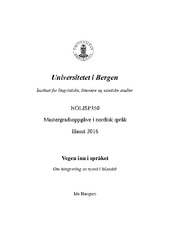| dc.description.abstract | Nye samfunnstilhøve og ny teknologi krev nye nemningar. Medan mange språksamfunn løyser trongen til nye ord gjennom å låna frå kvarandre, har heimleg nyorddanning vore den rådande norma i islandsk. I denne oppgåva undersøker eg korleis eit utval islandske nyord frå perioden 1880-2010 har greidd seg etter at dei vart introduserte i språksamfunnet. Målet med oppgåva har vore å 1) undersøka kor langt dei innsamla nyorda er komne i integreringa, og 2) undersøka korleis eigenskapar ved orda og eventuelt ytre faktorar kan ha verka inn på integreringa deira. Eg har sjølv samla orda eg undersøker, og ordsamlinga inneheld hovudsakleg ålmennspråklege, heimleg danna nyord. Ei særleg viktig kjelde i arbeidet har vore avis- og tidsskriftsamlinga Tímarit.is, som eg mellom anna har nytta for å observera bruksfrekvensen av nyorda. På bakgrunn av søk i Tímarit.is har eg kategorisert nyorda etter integreringssteg. Fleire lingvistar peikar på at ord danna med frekvente og produktive orddanningsprosessar er lettast å forstå for språkbrukarane. Eit sentralt spørsmål i undersøkinga mi er om dette kan ha hatt noko å seia for integreringa til dei innsamla nyorda. I kartlegginga av eigenskapar ved orda har eg særleg lagt vekt på dei eigenskapane som ifylgje dei teoretiske tilnærmingane er kopla til korleis språkbrukarane forstår orda. I kapittel 1 gjer eg greie for problemstillinga og viktige omgrep knytte til integreringsprosessen. Kapittel 2 er ein gjennomgang av moderne nyorddanning og -forsking i islandsk, medan eg i kapittel 3 greier ut om islandske orddanningsmåtar. I kapittel 4 presenterer eg teori som gjeld integreringa av nye ord. Kapittel 5 er eigna til kjelder, arbeidsspørsmål og framgangsmåte. Analysen fylgjer i kapittel 6, der eg særleg ser på dei morfologiske og semantiske eigenskapane til orda. Kapittel 7 er ei avsluttande drøfting. Analysen syner at produktivitet har mykje å seia for kva for ord som vert danna, men å vera produktivt danna er ikkje nok til å sikra ordet ein plass i språket. Den viktigaste suksessfaktoren ser ut til å vera ei mest mogeleg direkte og konvensjonell kopling mellom form og tyding. Den viktigaste utanomspråklege faktoren er tid - eldre ord greier seg betre enn yngre synonym. Funna er ikkje utan unntak, og for svært mange ord kan så mange faktorar ha verka samstundes at det er uråd å seia kva som har vege tyngst. | en_US |
| dc.description.abstract | The Journey Into Language. On New Words Becoming Part of Islandic As society and technology evolves, the requirement for new words emerges. With the demand for new words, the prevailing norm in a speech community has been to adopt words from other languages. In Iceland, however, the preferred solution is to coin new words from Icelandic word elements. In this thesis, I examine a selection of Icelandic neologisms, all of which were introduced between 1880 and 2010, and try to determine how successful they have been. This thesis aims to 1) investigate how far the new words has come in the process of becoming part of the norm, and 2) examine how features of words and external factors influence their process of becoming accepted and established. I have personally collected the words that I am investigating, and the collection mainly consists of common words coined from Icelandic word elements. A particularly important source has been Tímarit.is, an open access digital library which hosts digital editions of newspapers and periodicals. Here, I have been able to trace the neologisms and study their frequency. Based on these searches in Tímarit.is, I have categorized the new words by levels of integration. Many linguists agree upon the theory that words that are created through productive processes of word formation are easier to understand for speakers than others. One basic question in this thesis is thus whether this affects the establishing process of the collection of new words. In the survey of word features, I have mainly emphasized the features that, according to theoretical approaches, are connected to how the speakers understand the words. In Chapter 1, I introduce and elaborate on the research question and important terms that are connected to the process of becoming established words. Chapter 2 is a review of modern word creation and Icelandic research in this field. Chapter 3 is about Icelandic ways of creating new words, and in chapter 4 I present theories on integration of new words. Chapter 5 contains sources, topic related questions and procedure. Accordingly, the analyses follows in chapter 6. This analysis mainly emphasizes the morfological and semantical features of the words. The final discussion appears in chapter 7. The analysis shows that productivity largely determines how new words are coined, but being coined by a productive word-formation process is not enough for the word to remain in the language. However, the most important factor seems to be a direct and general connection between form and meaning. The most essential non-linguistic factor is time. Old words have a higher tendency to maintain their status than a newer synonym. The findings show that exeptions exist, and there might be many factors working together in several new words. Conclusions cannot be distinctively drawn as to which factors weigh the most. | en_US |
